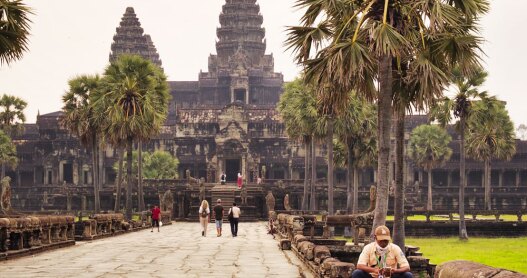Overview
When’s the best time to go to Siem Reap?
High season is from December to February. It’s the coolest and driest period and the most popular time to visit. While the weather is loveliest, the city and temples are crowded, so you’ll need to rise in the darkness to start exploring the temples at sunrise, before the tour groups arrive. March and April are the hottest months and best avoided if you can’t handle the heat. The days cool a little in May when the early rains come. June, when monsoon really kicks in, is wet, yet the countryside quickly greens and remains lush through to November. For many, the wet or green season is the best time to visit.
How to get around Siem Reap
As the gateway to Angkor Archaeological Park, one of Asia’s star attractions and Cambodia’s main tourist destination, Siem Reap’s international airport is busy, with frequent flights arriving from around Asia. The petite airport is not equipped to handle large long-haul flights, so you’ll likely fly via Bangkok, Singapore, Kuala Lumpur, or any number of Asian capitals, before transferring to a smaller jet. This means you can take advantage of low-cost airlines like Air Asia. If traveling overland, good bus services exist between Hanoi and the Cambodian capital Phnom Penh (5 hours) and from there to Siem Reap (7-8 hours), and from Bangkok via the border town of Poipet to Siem Reap (8-9 hours). It’s also possible to take a train from Bangkok and then a bus from the border.
Taxis (US$7) or tuk-tuks ($6), pre-arranged with your hotel, are the main wheels from the airport to your hotel, but once in town, it’s tuk-tuk all the way. Expect to pay $1–$2 for short journeys around town, while day trips to the temples can cost $10–$20 depending on the duration and distance. If you’re not afraid of chaotic traffic and reckless unlicensed local drivers, you can rent bicycles for as little as $1–$2 a day for a basic bike, and up to $5 a day for a top quality mountain bike. Foreign tourists are prohibited from riding motorbikes for safety reasons.
Can’t miss things to do in Siem Reap
Spend a Sunday evening on Road 60 on the edge of town, tucking into street food and sipping cold beers on roadside picnic mats. Cambodians call it “the local’s Pub Street,” although it has much more of a family vibe and fun-fair feel, with its few simple kids’ rides, than the backpacker party street—also known as Pub Street—in the center of town. It should not be confused with another “Khmer Pub Street,” a gritty street off Airport Road (National Highway 6), lined with local beer gardens (no signs in English) and karaoke or “KTVs.” If you feel like singing karaoke, head to the Corner bar instead.
Food and drink to try in Siem Reap
Cambodian cuisine is one of Asia’s most misunderstood. The better-known Royal Thai Cuisine of neighboring Thailand was actually born from Royal Khmer Cuisine. Restaurants such as Sugar Palm and Chanrey Tree serve up refined renditions of home-style Cambodian food, while Cuisine Wat Damnak, recently voted Best Restaurant in Cambodia among Asia’s 50 Best Restaurants, is renowned for its creative contemporary Cambodian cuisine. Markets, roadside stalls, mobile carts, and roaming vendors offer tasty street-food treats such as soups, barbecue skewered meats, noodle dishes, and pork and rice, while countless international restaurants serve up everything from authentic Korean and Indian to Italian and French cuisines.
Culture in Siem Reap
As you’d expect from a civilization that built the Angkor temples, the Khmer Empire was artistically rich, with talented sculptors, artists, dancers, and musicians. Art and sculpture are on display in the elaborate carvings and bas-reliefs on the temple walls and at Angkor National Museum. Nightly Apsara dance performances, accompanied by classical Khmer musicians, are held at dozens of venues around the city. Wat Bo Pagoda is the location of twice-weekly shows of traditional shadow puppetry and musical ensembles, while the Bambu Stage showcases contemporary dance and the big top behind the Museum is home to nightly performances by the quirky Phare Cambodian Circus.
The biggest party of the year for Cambodians is Khmer New Year, celebrated around the same time as Thailand’s Songkran, though less about water fights and more about pagoda activities such as making offerings to the monks, worshipping ancestors, and washing Buddha statues. While the main holiday lasts over three days, Cambodians will take a week to 10 days off if they are able to return to their hometowns. In Siem Reap, it’s the only time of year that Pub Street and Angkor Archaeological Park teem with groups of Cambodian friends and families. Traditional games, dancing, and concerts take place around the park, including in front of Angkor Wat. It’s a wonderful time to visit.
Local travel tips for Siem Reap
The average three-day stay in Siem Reap isn’t nearly long enough. Try to spend a week to explore the best of the Khmer Empire archaeological sites and more off-the-beaten-path ruins, as well as to experience the city beyond the temples.






